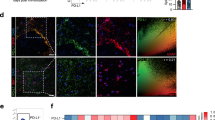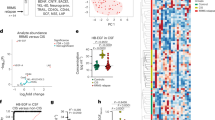Abstract
Interleukin 17 (IL-17) is a signature cytokine of Th17 cells. We previously reported that deletion of NF-κB activator 1 (Act1), the key transducer of IL-17 receptor signaling, from the neuroectodermal lineage in mice (neurons, oligodendrocytes and astrocytes) results in attenuated severity of experimental autoimmune encephalomyelitis (EAE). Here we examined the cellular basis of this observation. EAE disease course was unaffected by deletion of Act1 in neurons or mature oligodendrocytes, and Act1 deletion in astrocytes only modestly affected disease course. Deletion of Act1 in NG2+ glia resulted in markedly reduced EAE severity. Furthermore, IL-17 induced characteristic inflammatory mediator expression in NG2+ glial cells. IL-17 also exhibited strong inhibitory effects on the maturation of oligodendrocyte lineage cells in vitro and reduced their survival. These data identify NG2+ glia as the major CNS cellular target of IL-17 in EAE. The sensitivity of oligodendrocyte lineage cells to IL-17–mediated toxicity further suggests a direct link between inflammation and neurodegeneration in multiple sclerosis.
This is a preview of subscription content, access via your institution
Access options
Subscribe to this journal
Receive 12 print issues and online access
$209.00 per year
only $17.42 per issue
Buy this article
- Purchase on Springer Link
- Instant access to full article PDF
Prices may be subject to local taxes which are calculated during checkout






Similar content being viewed by others
References
Sawcer, S. et al. Genetic risk and a primary role for cell-mediated immune mechanisms in multiple sclerosis. Nature 476, 214–219 (2011).
Becher, B., Bechmann, I. & Greter, M. Antigen presentation in autoimmunity and CNS inflammation: how T lymphocytes recognize the brain. J. Mol. Med. (Berl) 84, 532–543 (2006).
Sospedra, M. & Martin, R. Immunology of multiple sclerosis. Annu. Rev. Immunol. 23, 683–747 (2005).
Steinman, L. Multiple sclerosis: a two-stage disease. Nat. Immunol. 2, 762–764 (2001).
Ransohoff, R.M. Animal models of multiple sclerosis: the good, the bad and the bottom line. Nat. Neurosci. 15, 1074–1077 (2012).
Stromnes, I.M., Cerretti, L.M., Liggitt, D., Harris, R.A. & Goverman, J.M. Differential regulation of central nervous system autoimmunity by T(H)1 and T(H)17 cells. Nat. Med. 14, 337–342 (2008).
Kroenke, M.A., Carlson, T.J., Andjelkovic, A.V. & Segal, B.M. IL-12– and IL-23–modulated T cells induce distinct types of EAE based on histology, CNS chemokine profile and response to cytokine inhibition. J. Exp. Med. 205, 1535–1541 (2008).
Cua, D.J. et al. Interleukin-23 rather than interleukin-12 is the critical cytokine for autoimmune inflammation of the brain. Nature 421, 744–748 (2003).
Veldhoen, M., Hocking, R.J., Atkins, C.J., Locksley, R.M. & Stockinger, B. TGFbeta in the context of an inflammatory cytokine milieu supports de novo differentiation of IL-17–producing T cells. Immunity 24, 179–189 (2006).
Mangan, P.R. et al. Transforming growth factor–beta induces development of the T(H)17 lineage. Nature 441, 231–234 (2006).
Komiyama, Y. et al. IL-17 plays an important role in the development of experimental autoimmune encephalomyelitis. J. Immunol. 177, 566–573 (2006).
Hu, Y. et al. IL-17RC is required for IL-17A– and IL-17F–dependent signaling and the pathogenesis of experimental autoimmune encephalomyelitis. J. Immunol. 184, 4307–4316 (2010).
Li, X. et al. Act1, an NF-kappa B–activating protein. Proc. Natl. Acad. Sci. USA 97, 10489–10493 (2000).
Leonardi, A., Chariot, A., Claudio, E., Cunningham, K. & Siebenlist, U. CIKS, a connection to Ikappa B kinase and stress-activated protein kinase. Proc. Natl. Acad. Sci. USA 97, 10494–10499 (2000).
Qian, Y., Zhao, Z., Jiang, Z. & Li, X. Role of NF kappa B activator Act1 in CD40-mediated signaling in epithelial cells. Proc. Natl. Acad. Sci. USA 99, 9386–9391 (2002).
Qian, Y. et al. The adaptor Act1 is required for interleukin 17–dependent signaling associated with autoimmune and inflammatory disease. Nat. Immunol. 8, 247–256 (2007).
Kang, Z. et al. Astrocyte-restricted ablation of interleukin-17–induced Act1-mediated signaling ameliorates autoimmune encephalomyelitis. Immunity 32, 414–425 (2010).
Raasch, J. et al. IkappaB kinase 2 determines oligodendrocyte loss by non-cell-autonomous activation of NF-kappaB in the central nervous system. Brain 134, 1184–1198 (2011).
van Loo, G. et al. Inhibition of transcription factor NF-κB in the central nervous system ameliorates autoimmune encephalomyelitis in mice. Nat. Immunol. 7, 954–961 (2006).
Nishiyama, A., Komitova, M., Suzuki, R. & Zhu, X. Polydendrocytes (NG2 cells): multifunctional cells with lineage plasticity. Nat. Rev. Neurosci. 10, 9–22 (2009).
Richardson, W.D., Young, K.M., Tripathi, R.B. & McKenzie, I. NG2-glia as multipotent neural stem cells: fact or fantasy? Neuron 70, 661–673 (2011).
Gold, R., Linington, C. & Lassmann, H. Understanding pathogenesis and therapy of multiple sclerosis via animal models: 70 years of merits and culprits in experimental autoimmune encephalomyelitis research. Brain 129, 1953–1971 (2006).
Weaver, A. et al. An elevated matrix metalloproteinase (MMP) in an animal model of multiple sclerosis is protective by affecting Th1/Th2 polarization. FASEB J. 19, 1668–1670 (2005).
Yan, Y. et al. CNS-specific therapy for ongoing EAE by silencing IL-17 pathway in astrocytes. Mol. Ther. 20, 1338–1348 (2012).
Siffrin, V. et al. In vivo imaging of partially reversible Th17 cell–induced neuronal dysfunction in the course of encephalomyelitis. Immunity 33, 424–436 (2010).
Baumann, N. & Pham-Dinh, D. Biology of oligodendrocyte and myelin in the mammalian central nervous system. Physiol. Rev. 81, 871–927 (2001).
Fancy, S.P., Chan, J.R., Baranzini, S.E., Franklin, R.J. & Rowitch, D.H. Myelin regeneration: a recapitulation of development? Annu. Rev. Neurosci. 34, 21–43 (2011).
Trotter, J., Karram, K. & Nishiyama, A. NG2 cells: Properties, progeny and origin. Brain Res. Rev. 63, 72–82 (2010).
Menn, B. et al. Origin of oligodendrocytes in the subventricular zone of the adult brain. J. Neurosci. 26, 7907–7918 (2006).
Zhu, X., Bergles, D.E. & Nishiyama, A. NG2 cells generate both oligodendrocytes and gray matter astrocytes. Development 135, 145–157 (2008).
Emery, B. et al. Myelin gene regulatory factor is a critical transcriptional regulator required for CNS myelination. Cell 138, 172–185 (2009).
Zhou, Q., Wang, S. & Anderson, D.J. Identification of a novel family of oligodendrocyte lineage–specific basic helix-loop-helix transcription factors. Neuron 25, 331–343 (2000).
Schüller, U. et al. Acquisition of granule neuron precursor identity is a critical determinant of progenitor cell competence to form Shh-induced medulloblastoma. Cancer Cell 14, 123–134 (2008).
Yu, W.P., Collarini, E.J., Pringle, N.P. & Richardson, W.D. Embryonic expression of myelin genes: evidence for a focal source of oligodendrocyte precursors in the ventricular zone of the neural tube. Neuron 12, 1353–1362 (1994).
Lappe-Siefke, C. et al. Disruption of Cnp1 uncouples oligodendroglial functions in axonal support and myelination. Nat. Genet. 33, 366–374 (2003).
Dugas, J.C. et al. Dicer1 and miR-219 are required for normal oligodendrocyte differentiation and myelination. Neuron 65, 597–611 (2010).
Kaga, Y. et al. Mice with conditional inactivation of fibroblast growth factor receptor-2 signaling in oligodendrocytes have normal myelin, but display dramatic hyperactivity when combined with Cnp1 inactivation. J. Neurosci. 26, 12339–12350 (2006).
Paintlia, M.K., Paintlia, A.S., Singh, A.K. & Singh, I. Synergistic activity of interleukin-17 and tumor necrosis factor-alpha enhances oxidative stress-mediated oligodendrocyte apoptosis. J. Neurochem. 116, 508–521 (2011).
Furuta, S. et al. IL-25 causes apoptosis of IL-25R–expressing breast cancer cells without toxicity to nonmalignant cells. Sci. Transl. Med. 3, 78ra31 (2011).
Simon, C., Gotz, M. & Dimou, L. Progenitors in the adult cerebral cortex: cell cycle properties and regulation by physiological stimuli and injury. Glia 59, 869–881 (2011).
Nishiyama, A., Chang, A. & Trapp, B.D. NG2+ glial cells: a novel glial cell population in the adult brain. J. Neuropathol. Exp. Neurol. 58, 1113–1124 (1999).
Lee, Y. et al. Oligodendroglia metabolically support axons and contribute to neurodegeneration. Nature 487, 443–448 (2012).
Fünfschilling, U. et al. Glycolytic oligodendrocytes maintain myelin and long-term axonal integrity. Nature 485, 517–521 (2012).
Butts, B.D., Houde, C. & Mehmet, H. Maturation-dependent sensitivity of oligodendrocyte lineage cells to apoptosis: implications for normal development and disease. Cell Death Differ. 15, 1178–1186 (2008).
Franklin, R.J. & Ffrench-Constant, C. Remyelination in the CNS: from biology to therapy. Nat. Rev. Neurosci. 9, 839–855 (2008).
Lev, N., Barhum, Y., Melamed, E. & Offen, D. Bax-ablation attenuates experimental autoimmune encephalomyelitis in mice. Neurosci. Lett. 359, 139–142 (2004).
Hisahara, S., Okano, H. & Miura, M. Caspase-mediated oligodendrocyte cell death in the pathogenesis of autoimmune demyelination. Neurosci. Res. 46, 387–397 (2003).
Mc Guire, C., Beyaert, R. & van Loo, G. Death receptor signaling in central nervous system inflammation and demyelination. Trends Neurosci. 34, 619–628 (2011).
Hara, H., Nanri, Y., Tabata, E., Mitsutake, S. & Tabira, T. Identification of astrocyte-derived immune suppressor factor that induces apoptosis of autoreactive T cells. J. Neuroimmunol. 233, 135–146 (2011).
Patel, J. & Balabanov, R. Molecular mechanisms of oligodendrocyte injury in multiple sclerosis and experimental autoimmune encephalomyelitis. Int. J. Mol. Sci. 13, 10647–10659 (2012).
Qian, Y. et al. Act1, a negative regulator in CD40- and BAFF-mediated B cell survival. Immunity 21, 575–587 (2004).
Bajenaru, M.L. et al. Astrocyte-specific inactivation of the neurofibromatosis 1 gene (NF1) is insufficient for astrocytoma formation. Mol. Cell. Biol. 22, 5100–5113 (2002).
Frugier, T. et al. Nuclear targeting defect of SMN lacking the C-terminus in a mouse model of spinal muscular atrophy. Hum. Mol. Genet. 9, 849–858 (2000).
Pedraza, C.E., Monk, R., Lei, J., Hao, Q. & Macklin, W.B. Production, characterization and efficient transfection of highly pure oligodendrocyte precursor cultures from mouse embryonic neural progenitors. Glia 56, 1339–1352 (2008).
Chen, Y. et al. Isolation and culture of rat and mouse oligodendrocyte precursor cells. Nat. Protoc. 2, 1044–1051 (2007).
Acknowledgements
We gratefully acknowledge W.B. Stallcup (Burnham Institute for Medical Research) for providing antibodies to NG2 and K.-A. Nave for providing Cnp1-cre transgenic mice (Max Planck Institute of Experimental Medicine). We also thank the Dana-Farber Cancer Institute for providing the Olig2-cre transgenic mice. This investigation was supported by grants from the US National Institutes of Health (R01NS071996 and P01HL103453).
Author information
Authors and Affiliations
Contributions
Z.K. designed and performed most of the experiments, interpreted the data, and wrote part of the manuscript. C.W. carried out most of the western blotting. J. Zepp did some western blotting and manuscript editing. L.W. performed some immunohistochemical staining. K.S. aided in western blotting, immunohistochemical staining and real-time PCR. J. Zhao performed statistical analysis. U.C. executed mouse breeding and cell culture. P.E.D. helped with experimental design. B.D.T. interpreted data. R.M.R. contributed to experimental design and manuscript writing. X.L. was integral for experimental design, manuscript writing, data interpretation and project coordination.
Corresponding author
Ethics declarations
Competing interests
The authors declare no competing financial interests.
Supplementary information
Supplementary Text and Figures
Supplementary Figures 1–6 (PDF 3759 kb)
Rights and permissions
About this article
Cite this article
Kang, Z., Wang, C., Zepp, J. et al. Act1 mediates IL-17–induced EAE pathogenesis selectively in NG2+ glial cells. Nat Neurosci 16, 1401–1408 (2013). https://doi.org/10.1038/nn.3505
Received:
Accepted:
Published:
Issue Date:
DOI: https://doi.org/10.1038/nn.3505
This article is cited by
-
Oligodendrocyte progenitor cells in Alzheimer’s disease: from physiology to pathology
Translational Neurodegeneration (2023)
-
Myelination-independent functions of oligodendrocyte precursor cells in health and disease
Nature Neuroscience (2023)
-
Roles of NG2 Glia in Cerebral Small Vessel Disease
Neuroscience Bulletin (2023)
-
IL-17A Facilitates Entry of Autoreactive T-Cells and Granulocytes into the CNS During EAE
NeuroMolecular Medicine (2023)
-
Inflammatory Cytokines Associated with Multiple Sclerosis Directly Induce Alterations of Neuronal Cytoarchitecture in Human Neurons
Journal of Neuroimmune Pharmacology (2023)



